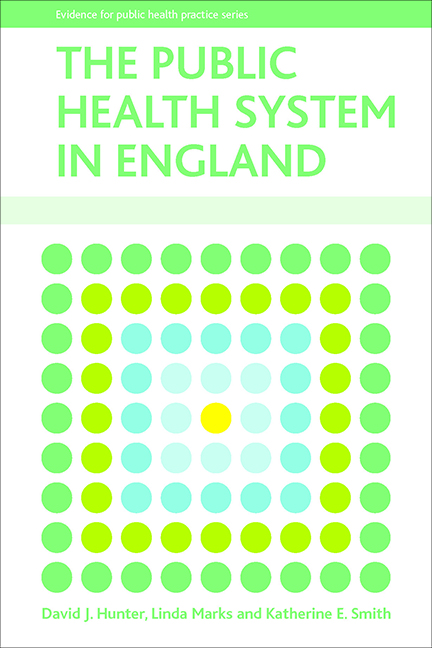Book contents
- Frontmatter
- Contents
- List of boxes and figures
- Acknowledgements
- List of acronyms
- About the authors
- one Introduction
- two Public health and a public health system
- three The evolution of the public health function in England (1): 1974–97
- four The evolution of the public health function in England (2): 1997–2009
- five Current issues in the public health system in England
- six Looking to the future
- Appendix: NHS reorganisation – 1975–2009
- References
- Index
Appendix: NHS reorganisation – 1975–2009
Published online by Cambridge University Press: 01 September 2022
- Frontmatter
- Contents
- List of boxes and figures
- Acknowledgements
- List of acronyms
- About the authors
- one Introduction
- two Public health and a public health system
- three The evolution of the public health function in England (1): 1974–97
- four The evolution of the public health function in England (2): 1997–2009
- five Current issues in the public health system in England
- six Looking to the future
- Appendix: NHS reorganisation – 1975–2009
- References
- Index
Summary
The numerous reorganisations of the NHS since 1974 have each raised questions over the location and concentration of public health resources, the key responsibilities of public health professionals and their capacity to work effectively across health and local authorities, across regions and with primary care. The brief summary in this Appendix illustrates these points; diagrams are used to capture organisational snapshots within the various changes between 1974 and now.
Pre-1974 NHS: Medical Officer of Health
Up until 1974, the Medical Officer of Health (MOH) was based in local government, responsible for the health of the local population and the administration of community health services, including family planning, environmental health services, health visiting and health centres. The Health Education Council was formed in 1968 as a nondepartmental body registered as a charity. The specialty of community medicine was formed in 1972, heralding its future role in the NHS. (Figure A.1 shows the pre-1974 NHS.)
1974–82: community physicians based in district health authorities
With the 1974 NHS reorganisation and the creation of regional, area and district health authorities and community health councils, MOsH were replaced by community physicians, located in the new district health authorities as district medical officers or specialists in community medicine, and in area health authorities (AHAs), where they became increasingly involved in management and administration. For the first time, personal health services and environmental health services were separated. The former executive councils were replaced by family practitioner committees; AHAs corresponded to the new local government boundaries (outside London); health education departments were accountable to AHAs. However, joint consultative committees were also formed across the NHS and local authorities to promote partnership working (Figure A.2 shows the 1974 NHS.)
1982–89: from community medicine to directors of public health
In 1982, the tier of management represented by AHAs was replaced by 192 restructured district health authorities (DHAs). Elected local government members formed part of their membership. In 1984, general management was introduced and, in 1986, the NHS Management Board was established. In 1989, this was reorganised into the NHS Policy Board and the NHS Management Executive. In 1988, the Department of Health split from the Department of Health and Social Security. It was recommended (Acheson, 1988) that each DHA appoint a Director of Public Health, that the term ‘community medicine’ be replaced by ‘public health medicine’, and that the annual report of the MoH be resurrected.
- Type
- Chapter
- Information
- The Public Health System in England , pp. 161 - 166Publisher: Bristol University PressPrint publication year: 2010

